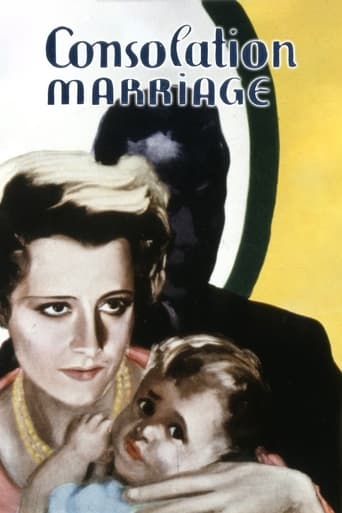marcslope
Pat O'Brien and Irene Dunne seem distinctly not made for each other in this odd romance, where she, a coffee shop proprietress, and he, a sports writer, are jilted by their respective fiances, meet cute, get a nice friendship going, and decide to get married. The open-marriage conceit feels daringly modern for 1931, but the dialog's pat and the plot coincidences are hard to swallow. Their respective true loves, Myrna Loy and Lester Vail, each come back from failed marriages at about the same time, and Dunne and O'Brien each leaves his/her spouse to pick up the pieces. It's hard to see why, when Loy is playing such a vain bore, and Vail such a needy weakling, and Dunne has an uncomfortable speech where she says goodbye to her baby daughter--her baby daughter!--to run off with an old lover. We all know the leads are going to discover they really love each other, but it's done so perfunctorily, with O'Brien just remarking to Loy, "Wouldn't it be funny if we turned out to be just friends?" and bolting upstairs to Dunne just in time for the happy fadeout. That's another thing--she can't make a great deal of money running a coffee shop, and he's unemployed more often than not, yet they have a gorgeous New York townhouse. Dunne's skill is somewhat evident, and O'Brien's fast talk is always entertaining, but he's not an ideal romantic lead, and this is not a credible romance.
secondtake
Consolation Marriage (1931)A really good movie, and a very serious drama. The sincerity of the acting and the attempt for clarity about true love and romantic first love are both impressive. Yes, it is somewhat of a familiar kind of film and filming, not quite breaking rules or surprising you as it goes, but in a way this just adds to its solidity.The two female stars are what drew me first to the title, and it's the underrated and subtle Irene Dunne who gives the whole drama its depth. Myrna Loy is a second woman with a small role, but it's fun to see her so early in her career. The men were known at the time, especially Pat O'Brien, but they do less to make it convincing that simply fill in Dunne's deeper performance.What drives the thing is the plot, which is really sincere. Two couples in two different scenes are shown as romantically idealized—the starry eyed kinds of couples, true love and be-happy-forever types. Very impractical but compelling. And they both break up. (This happens right away, not a spoiler.) So the woman from one and the man from the other (Dunne and O'Brien) meet at a restaurant. And they get along so well, and have in common that their perfect relationships were now suddenly ruined, they decide to date. And so on.So this "consolation marriage" is a kind of means to survive, and happily. And they make a deal that they will always remember that they each had "true loves" earlier and elsewhere. And that they would have an "open" marriage.Then the ex-lovers re-appear. Inevitably. And the moral conflict is in their faces. Good idea, well done. It doesn't take it to emotional depths or to the complexity all these crossed affections suggest, but it does try. And that's where the move works so well. Underrated, in my view. It's not a thrilling pre-code classic, but it's worth seeing.
wes-connors
Shopkeeper Irene Dunne (as Mary Brown) is in love with pianist Lester Vail (as Aubrey). Sports writer Pat O'Brien (as Steve Porter) expects to marry his high school "Juliet" Myrna Loy (as Elaine). Alas, Ms. Dunne and Mr. O'Brien lose their lovers to more well-heeled partners. Then, Dunne and O'Brien meet, get drunk, and bond in friendship as a cut-rate "Bonnie and Clyde" during a wild evening. Thinking any reconciliation with their true loves is impossible, Dunne and O'Brien decide to get married. Their "Consolation Marriage" is agreed to be an "open" one, but a child keeps O'Brien home and sober more often. Then, the marriages of Mr. Vail and Ms. Loy end - and, they want Dunne and O'Brien back... Predictable and unattractive, with some emphasis on the latter.**** Consolation Marriage (10/13/31) Paul Sloane ~ Irene Dunne, Pat O'Brien, John Halliday, Myrna Loy
David (Handlinghandel)
Since I first saw "The Awful Truth," Irene Dunne has been one of the few performers whose presence in a movie will make me watch it. No matter what.This one is a real case of no matter what.(For the record, the others include Jean Harlow, Jean Arthur, and Constance Bennett.)This is a women's picture, directed at a snail's pace.In it, Ms. Dunne sports an exceptionally unflattering hair design, which makes her virtually unrecognizable as the star of such classics as the above-mentioned "Awful Truth," Theodora Goes Wild," and "Showboat."She looks like Edna May Oliver. She looks like Eleanor Roosevelt (my greatest heroine of the past two or three hundred years but hardly a beauty.)In this poky tale, Dunne actually leaves her child briefly. The child is indeed pudgy and very unappealing but women must have stalked out of theaters at that point.She and Pat O'Brien are not the most likely of couples but they are meant in the plot not to be. They are certainly more believable than Dunne and Spencer Tracy in unendurable "A Guy Named Joe."


